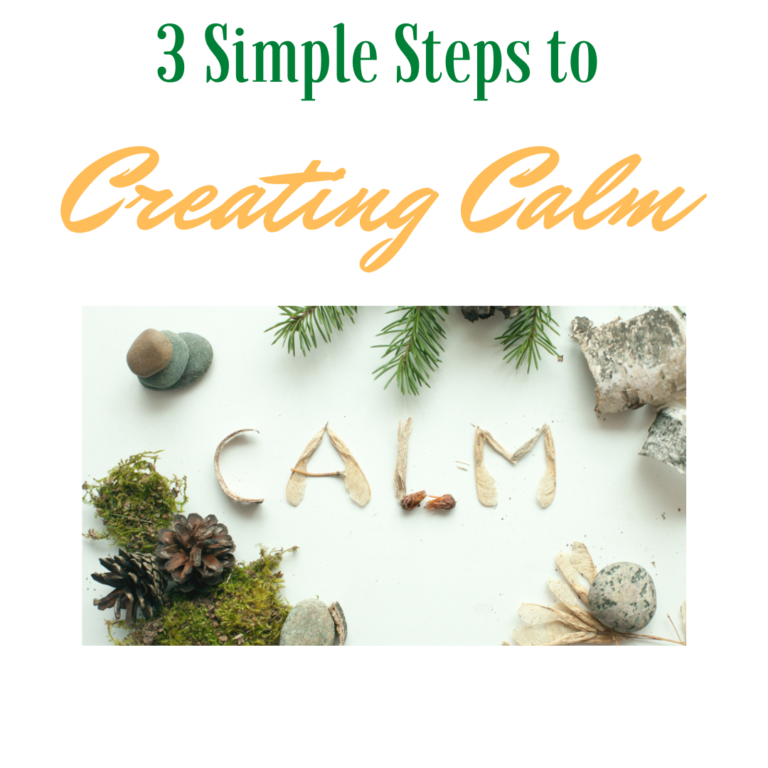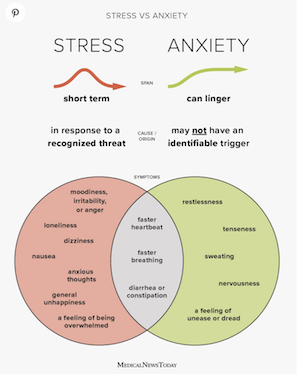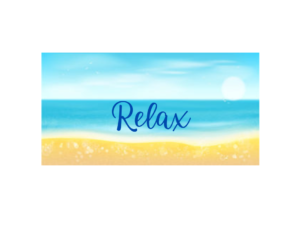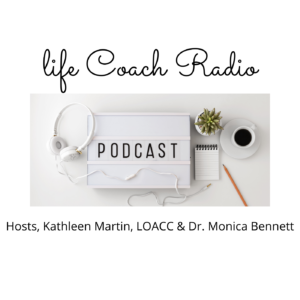
There are times when the challenges in life can become overwhelming. You feel a level of anxiety and stress that can feel like it is more than you can handle. These feelings have similar symptoms and bodily reactions, but there is a difference. Stress is a shorter experience in response to a recognized threat. Anxiety can linger and can seem as if nothing is triggering it.

If you are going to be able to ride the waves of anxiety and stress that come in all different ways daily and suddenly, life needs you to be prepared. Imagine someone who has never been on a surfboard who decides to go surfing during a hurricane when the ocean is raging and the waves are very big. If that person had been preparing by surfing in calmer waters and riding smaller waves, they would feel prepared if they ever wanted to surf big waves.
Otherwise, they will end up feeling out of control and incapable of handling the fear, anxiety and stress that will most definitely be a part of the experience.
When you take the time during each day to include a variety of proven stress and anxiety reduction practices, you will experience a sense of confidence and strength to be able to rise to any occasion, small or large. If you are experiencing high levels of stress and overwhelm at work, school and in your family, in your personal and professional relationships, with health, have experienced losses including jobs, money or the pain of losing a loved one, or are effected by the conflict in the world, etc., it is necessary to be prepared to make intelligent choices and help yourself to know that no matter what is happening, you will be ok and have what it takes. It’s like having superpowers that activate when you need them.
Here are some of the proven actions steps to take daily to help you to be prepared for life’s changes and to feel more at ease to be able to move quickly out from ‘stress response’ and to activate the ‘relaxation response’ which is how you need to feel and which will also create a sense of wellbeing. The sooner you begin to use these practices, the quicker you will begin to feel the results of feeling calmer and stronger. Think of these practices as a way of filling yourself up like you would your car gas tank so you can feel that you have the amount of fuel that will take you the distance in your everyday experiences and when it may be a longer, more difficult trip.
The starting place is using your BREATH. Why? It is proven that when we use an ‘intentional’ breathing pattern, the effect is that your nervous system will respond and become more relaxed.
How you breath affects every system of the body. It affects how your heart beats, circulation and digestion. It affects how your brain operates. Shallow, upper chest breathing is part of the typical stress response. Your breath is always available to use and you can depend on it to help you.
If we don’t breathe intentionally and consciously to train our responses, we will breath for survival centered in the chest and breath through our mouth too much which uses up our energy. A way to know this is to hyperventilate for about 20 seconds and see how you feel. Most will feel more stressed and tired.
Using the 2 Minute 6 Count Breath.

Taking the time to intentionally slow down your breath and guide it lower into your abdomen using the diaphragm, will create more calm. The 2 minute 6 count breath is a simple way to feel less stressed and anxious and will train your nervous system to be relaxed as a natural way of being.
Simply set aside 3 times -when you wake up, in the middle of the day and just before sleep. Be in a quiet place and set a timer for 2 minutes. (such as using your phone) Relax your body by tensing and releasing your shoulders and neck and dropping them down, relax your eyes and jaw. Scan your body for tension and relax those areas. Set the timer and close your eyes, put your hand on your heart (this directs your attention away from your head) and take slow long breaths down to your belly and count to six, pause and release with slow long breaths counting to six. Counting helps to reduce the amount of intrusive thoughts because you have given your brain a task. Repeat this pattern until the timer goes off. Take one more long slow breath and sit quietly. This breath pattern has been researched and shown to reduce anxiety and stress. Controlled conscious breathing can cause beneficial physiological changes that include:
- reduced levels of stress hormones in the blood
- reduced lactic acid build-up in muscle tissue
- balanced levels of oxygen and carbon dioxide in the blood
- lowered heart rate and blood pressure
- improved immune system functioning
- increased physical energy and mental clarity
- increased feelings of calm and wellbeing.
Add in more times per day to use this quick and simple breathing technique. As will everything you want to master, practicing more often is how we experience real long lasting results. In time, it will become the way your body responds to the feelings of overwhelm, stress and anxiety and will help you out of the stress response and into the relaxation response automatically. This breathing practice is also a way to begin to practice meditation which is simply quieting your thoughts and having more moments of relief from fear thinking and feeling.
**Important**
Some people find that concentrating on their breath actually provokes panic and hyperventilation. If this happens to you, look for another way to relax. Below are other ways.
Working it Out by Writing it Out

We all have overactive minds. We are thinking overtime about our problems and what is going wrong and trying to solve them feeling powerless. It is proven that we think over 60,000 thoughts in a day. Most of them are the kind that cause stress and anxiety. This overload can interrupt our sleep as we go to bed anxious and ruminate and think the same upsetting thoughts over and over trying to work it out. We are processing them, activating feelings and emotional responses and they affect our happiness, health and wellbeing. Remember, most fear based thoughts never come true and it is very important to know that you are not your thoughts, feelings and emotions; they are simply experiences that are temporary.
A way to help yourself is to write out how you are feeling. It is proven that expressive writing helps ease emotional pain. When you give your feelings attention and a way out to be expressed, you will feel better. You will find out about why you are feeling those emotions. You will become clearer about underlying beliefs and perceptions that you aren’t aware of and be able to give a new meaning to them. For instance, if you are in fear about your health because of a diagnosis and are upset and feeling powerless, write about it. Instead of feeling mostly fear and perhaps incapable of any other thoughts about it including optimism and hopefulness, you can begin to write out how you feel and why. You can challenge those underlying beliefs such as ‘I will never get better” and ‘ I’m not strong enough’. When you write, don’t hold back. Use a personal journal that you can write out all your thoughts in freely and without judgment. If you feel angry at this situation, or at someone; feeling fear about a circumstance or about someone in your life you feel responsible for or any number of scenarios, here is a place for all your thoughts and feelings that you may not have been able to express out loud.
Start your day writing, end your day writing and anytime you begin to feel anxious. Take out your journal and write out your feelings. This will help diffuse the impact before they take over. Release them though your hand onto paper. Let it become a new helpful habit. You will begin to feel less anxious and relieved from the release. Using this practice will give you a feeling of being in control and will also create an opening for creative solution oriented thinking, feeling and being.
Relax, Release, Replace

Learning how to relax and calm down the amount of anxiety and stress you are experiencing by using the 2 minute 6 count breath and writing it out will help you to begin to feel capable of letting go of the many fear based thoughts and feelings and replace them with the kind and quality of thoughts you need to believe that support you in your life. The practice of intentionally and consciously relaxing is the first step to being able to release the thoughts you are aware of that are causing the stress and replace them with the ones you want.
Thoughts and feelings that are described as fear, worry, doubt, overwhelm, upset, anger, frustration, discouragement, powerless etc. tend to have a quality to them that makes them difficult to release. They stick to us and are easily activated. What then can we do to let them go? First, make how you feel important to you more and more and help yourself by taking control faster. When you get the indication that you are beginning to feel one of these feelings, stop and ask ‘why do I feel like this?’ ‘What am I so ie: afraid of and worried about?’ ‘Is it true and is it always true or can I see this as temporary?’ Just by asking these questions, the intruding thoughts and feelings will move aside because your thinking is busy with the questions. Now you can replace them with statements such as ‘ even though I am worried and upset about (fill in the blank), I know that it is possible for me to find a solution; and ‘ I am looking forward to feeling better’. You don’t need to wait until the problem goes away or the situation changes to feel how you want to feel. Using this ‘Relax, Release, Replace’ practice often puts you in the place of power to ‘manage your mind and emotions.
Remind yourself that you have had difficult experiences and have managed to get through them smarter and stronger. We can learn and grow through the challenges. Treat your thoughts, feelings and emotions as information that help you to become clear about what you want. The clearer you are, the more likely you are to allow improvement and solutions.
***Find out how life coaching can help you to live the life you want. Click the green button below to schedule your complimentary discovery session.
Listen to life coaching conversations on Life Coach Radio podcast.
Click the image below or visit www.lifecoachradio.net
